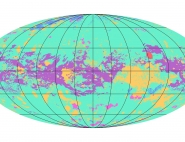Mission
![]()
Scientific Objectives about Saturn
The Cassini orbiter scientific objectives are as follows:
- Determine the temperature field, cloud properties and composition of Saturn's atmosphere.
- Image Saturn's atmosphere over a large range of latitudes and longitudes.
- Determine the two-cm wavelength radiometer thermal emission from the subcloud atmosphere.
- Study belt/zone structure variations in ammonia concentration.
- Measure the planet's global wind field, including its waves; make long-term observations of cloud features to see how they grow, evolve, and dissipate.
- Determine the internal structure and rotation of the deep atmosphere.
- Explore the unknown dynamical properties of the atmosphere.
- Examine ammonia as a tracer for atmospheric circulations.
- Determine the equator-to-pole temperature gradient and unknown subcloud longitudinal structures.
- Study daily variations and relationship between the ionosphere and the planet's magnetic field.
- Determine the composition, heat flux, and radiation environment present during Saturn's formation and evolution.
- Investigate sources and nature of Saturn's lightning.
- Understand Saturn's magnetosphere dynamics and the interactions between this magnetosphere and Saturn's multiples satellites, the rings and Saturn's atmosphere.
Scientific Objectives about Titan
The Cassini orbiter and Huygens descent module scientific objectives about Titan are as follows:
- Determine abundance of atmospheric constituents (including noble gases); establish isotope ratios for abundant elements; constrain scenarios of formation and evolution of Titan and its atmosphere.
- Observe vertical and horizontal distributions of trace gases; search for more complex organic molecules; investigate energy sources for atmospheric chemistry; model the photo-chemistry of the stratosphere; study formation and composition of aerosols.
- Measure winds and global temperatures; investigate cloud physics, general circulation and seasonal effects in Titan's atmosphere; search for lightning discharges.
- Determine the physical state, topography and the composition of the surface; infer the internal structure of the satellite.
- Investigate the upper atmosphere, its ionization, and its role as a source of neutral and ionized material for the magnetosphere of Saturn.
Mission
To reach Saturn in 2004, Cassini-Huygens is using a gravity assist from the planets it encounters to give it fresh momentum. This is why it flew by Venus twice, and returned to the vicinity of Earth in August 1999, before reaching Jupiter's gravitational zone in December 2000. The momentum supplied by these planets saved the equivalent of 75 tons of fuel and several decades of travel time.
![]()
The Cassini orbiter was inserted into orbit around Saturn on 1 July 2004. Since then, it has observed the planet and its surroundings.
Its passenger, the Huygens probe, entered Titan's atmosphere on 14 January 2005 and landed on its surface after a descent in the atmosphere of 2 hours and 30 minutes.
The initial mission was supposed to last four years. NASA announced the mission extension until July 2010.
On 3 February 2010, NASA announced a second extension of the mission duration to May 2017.


